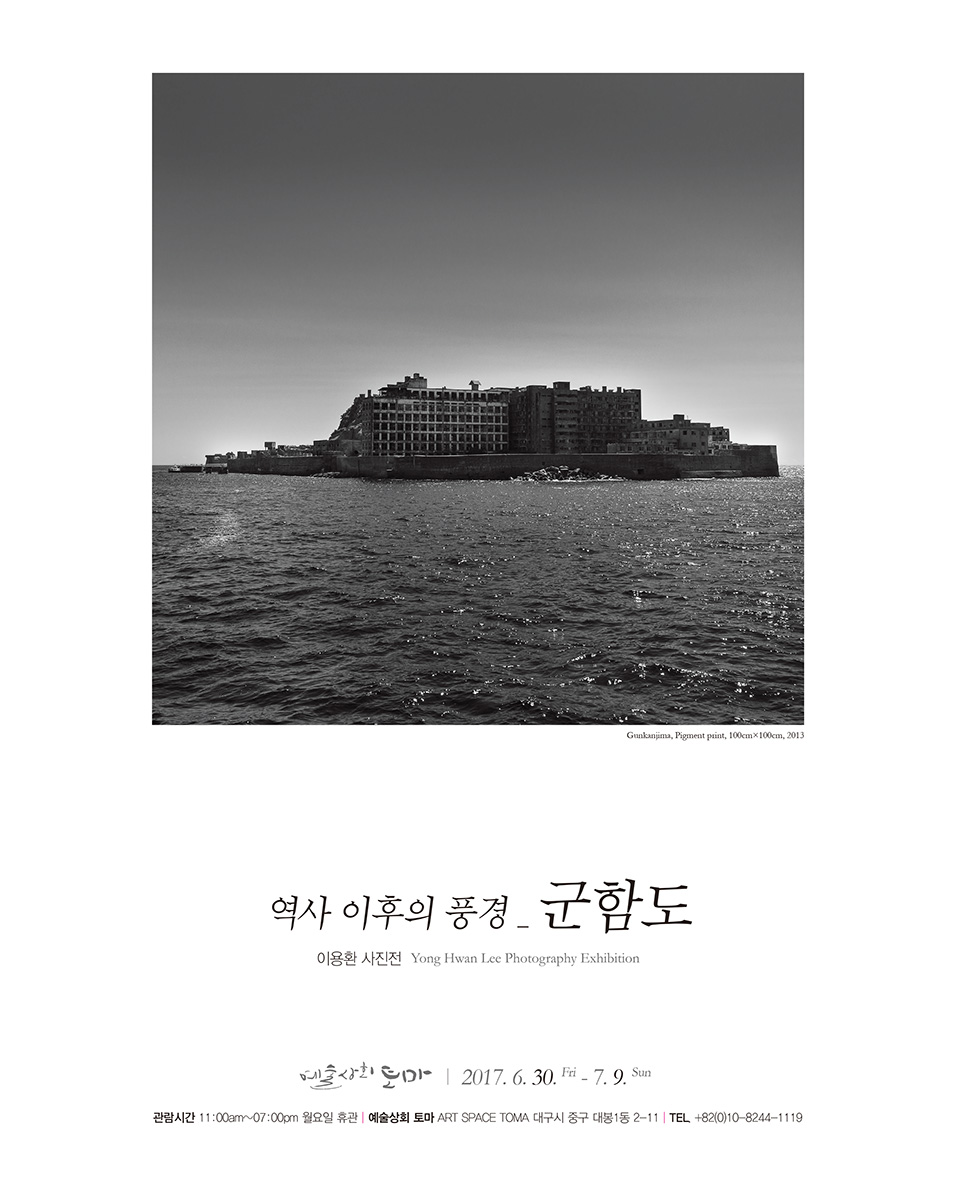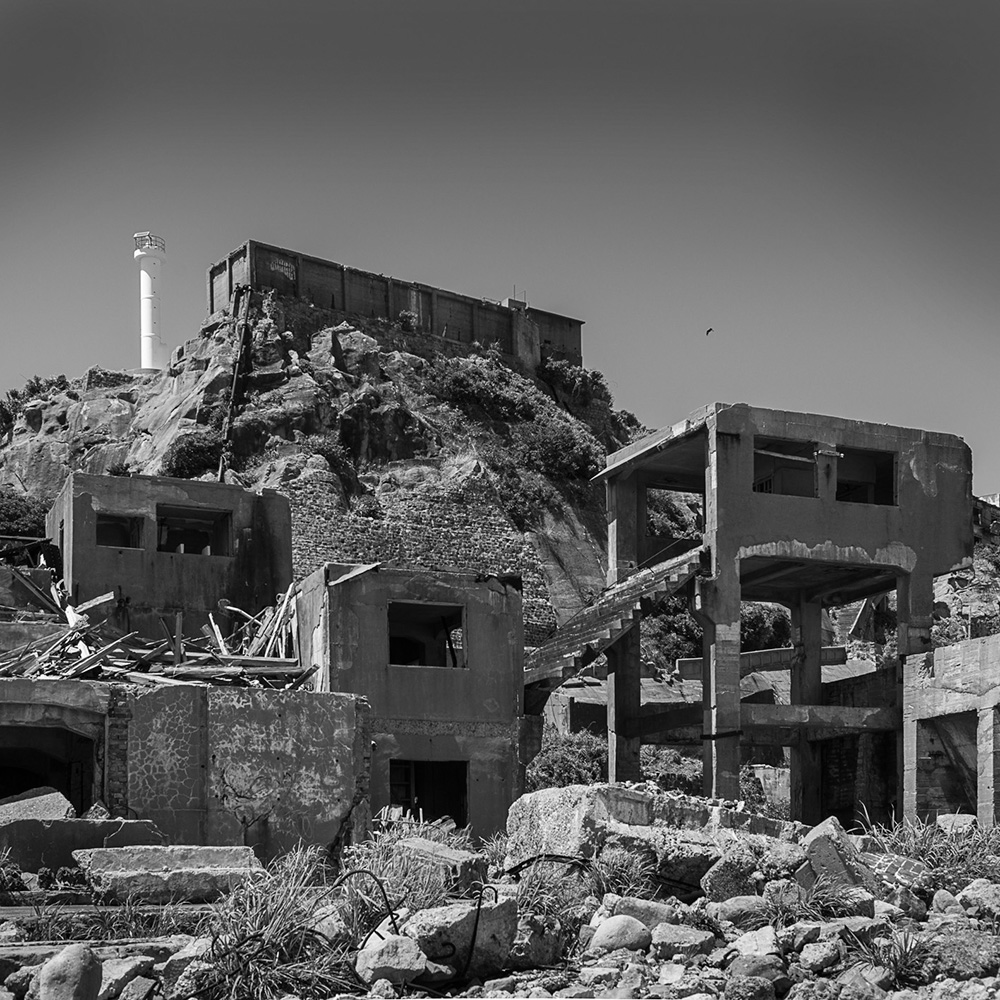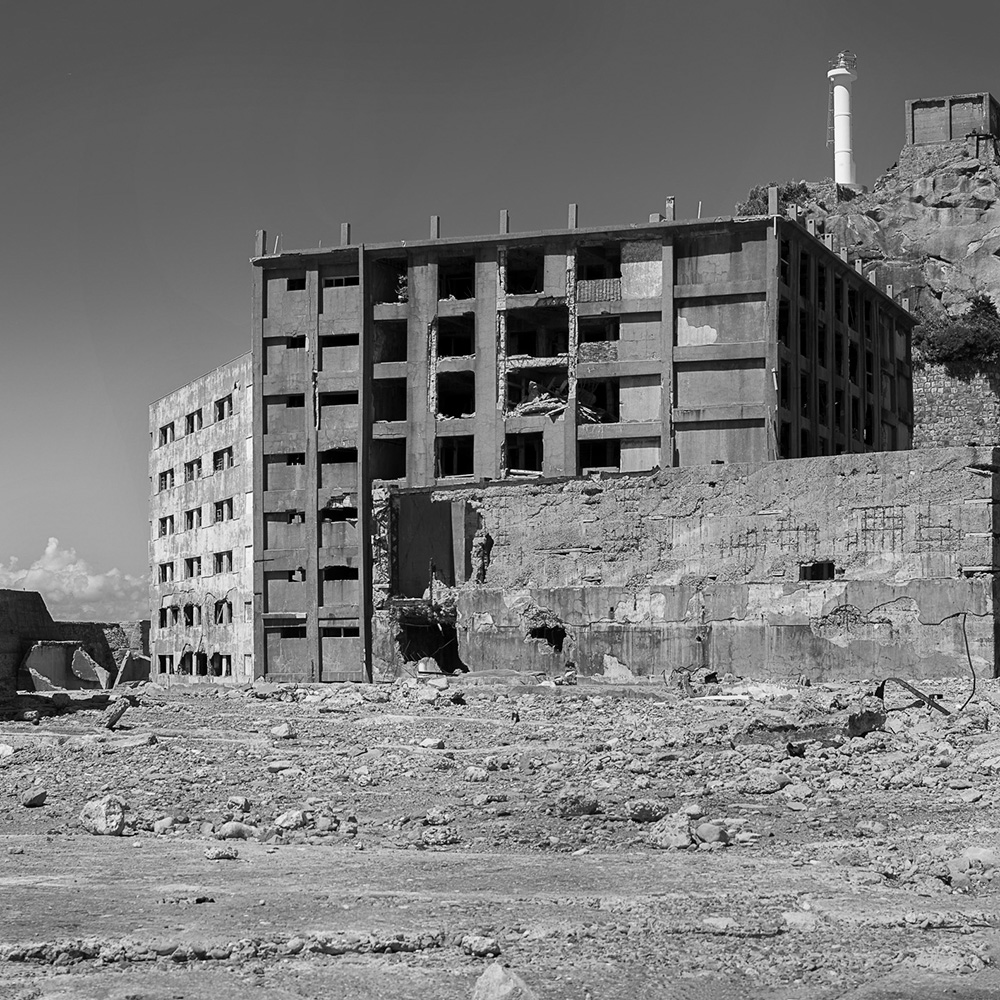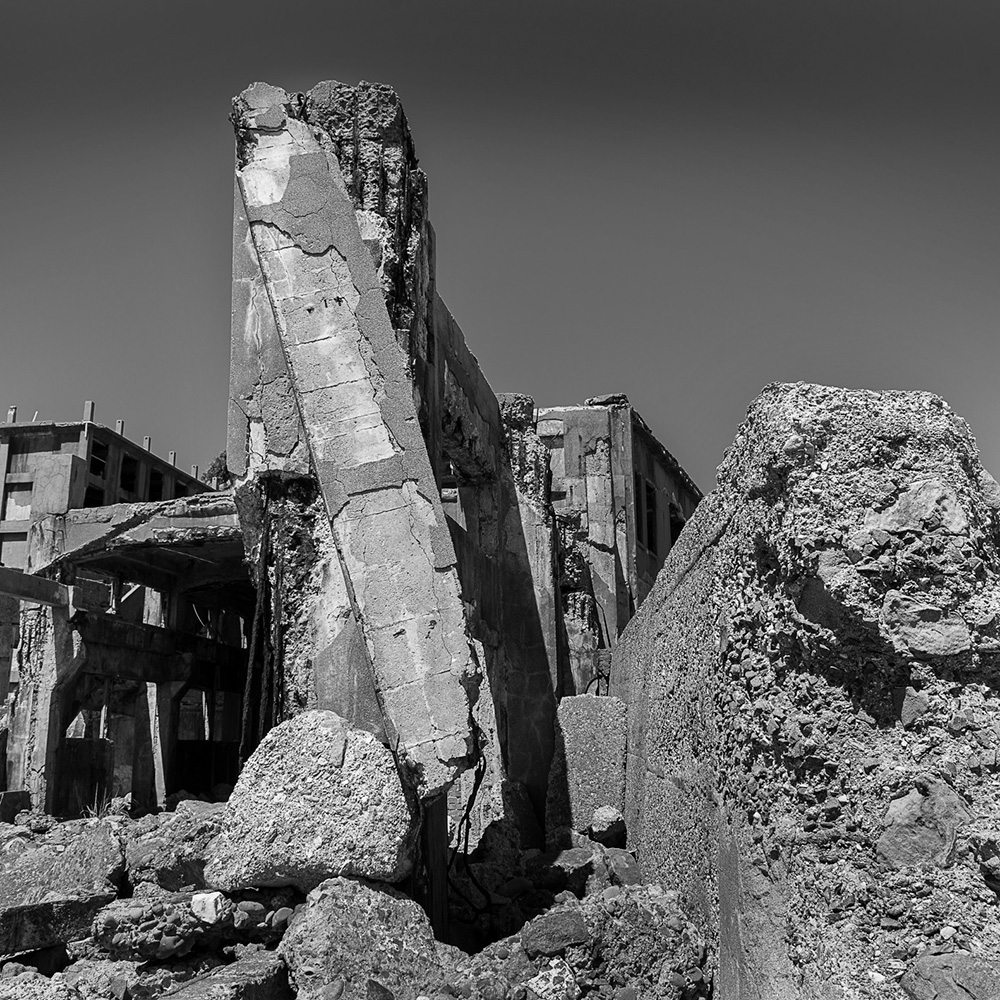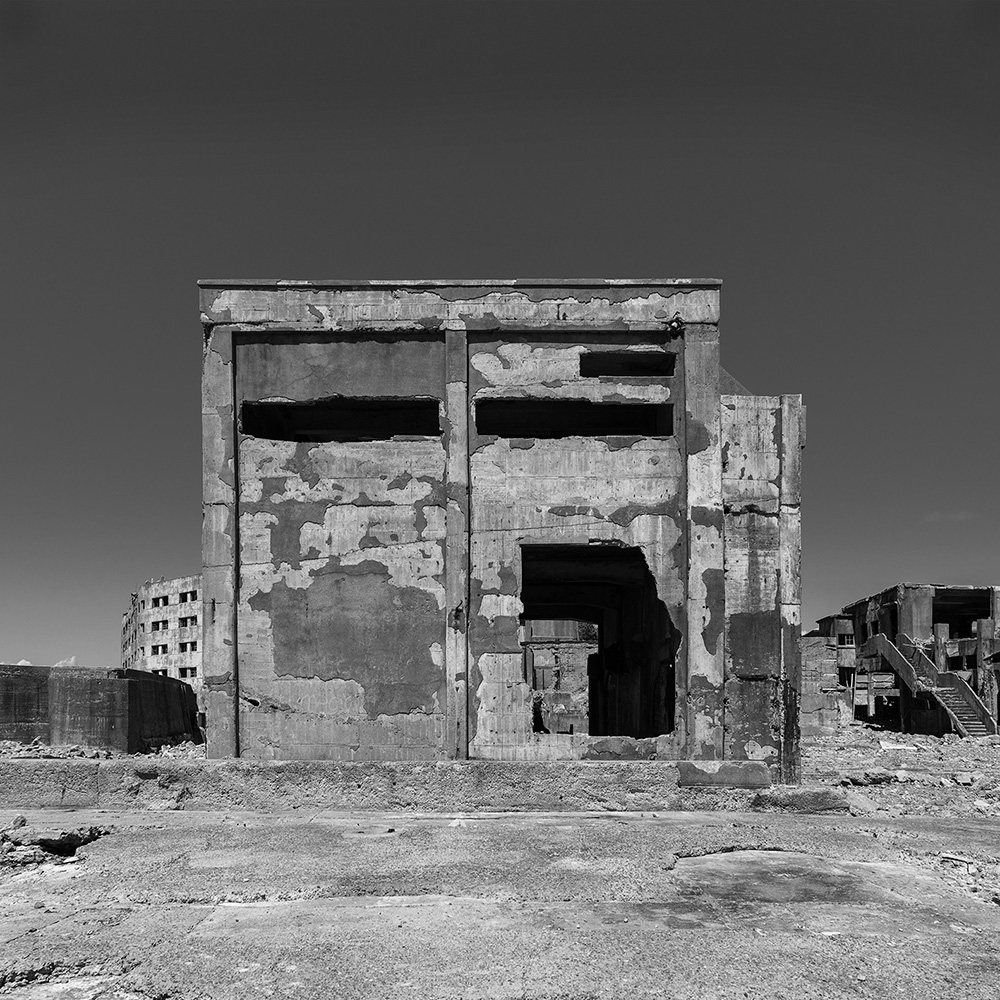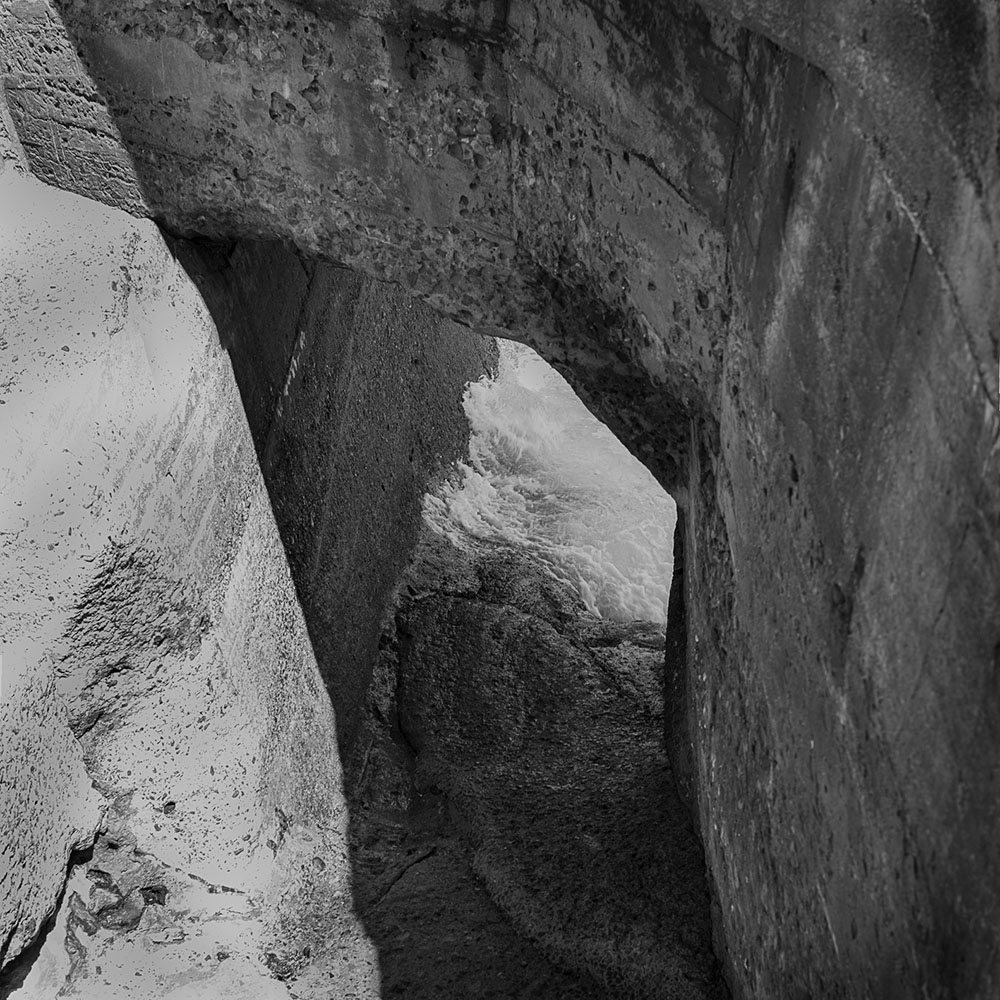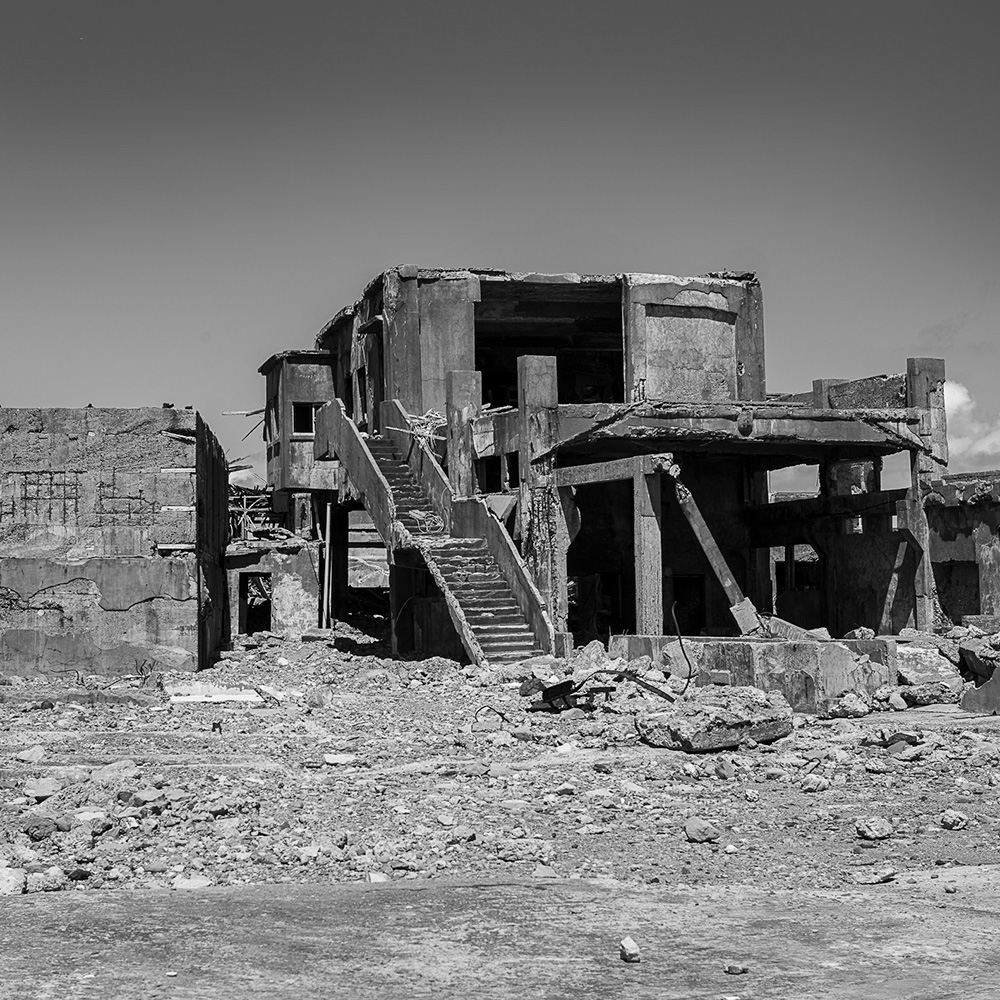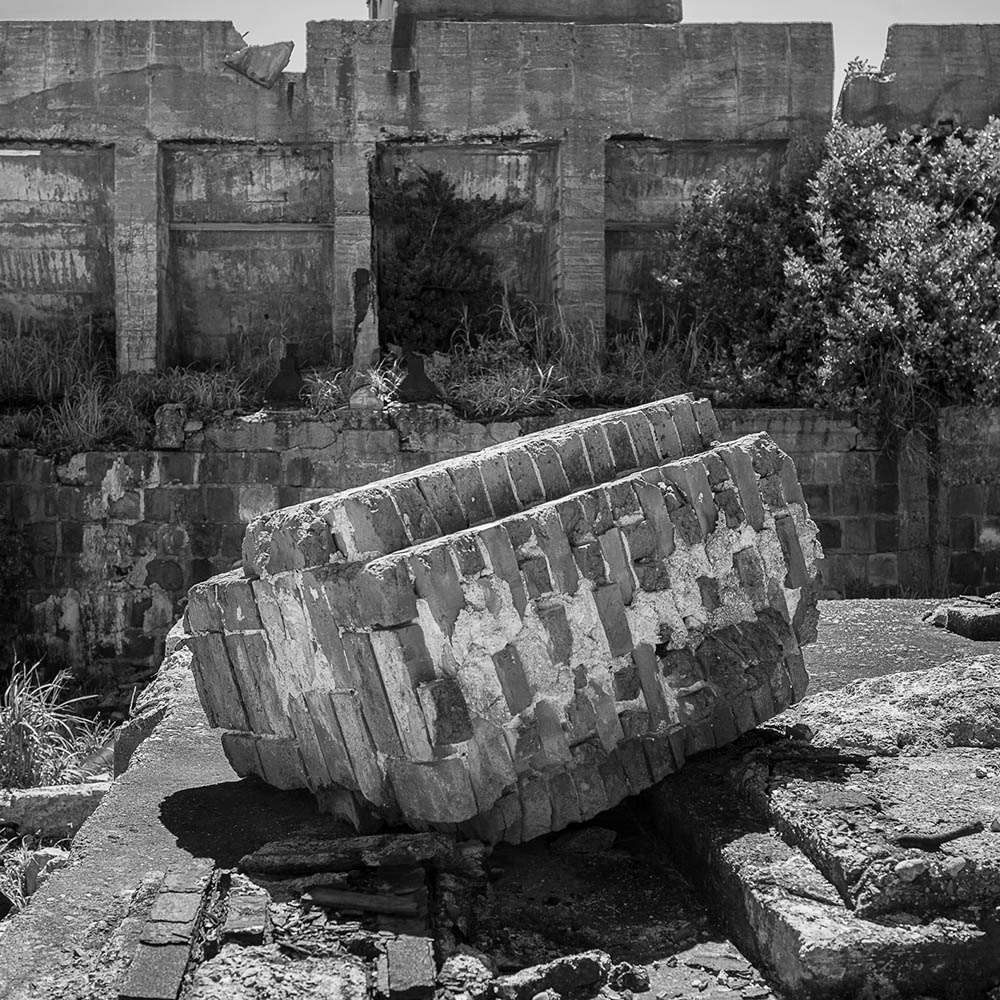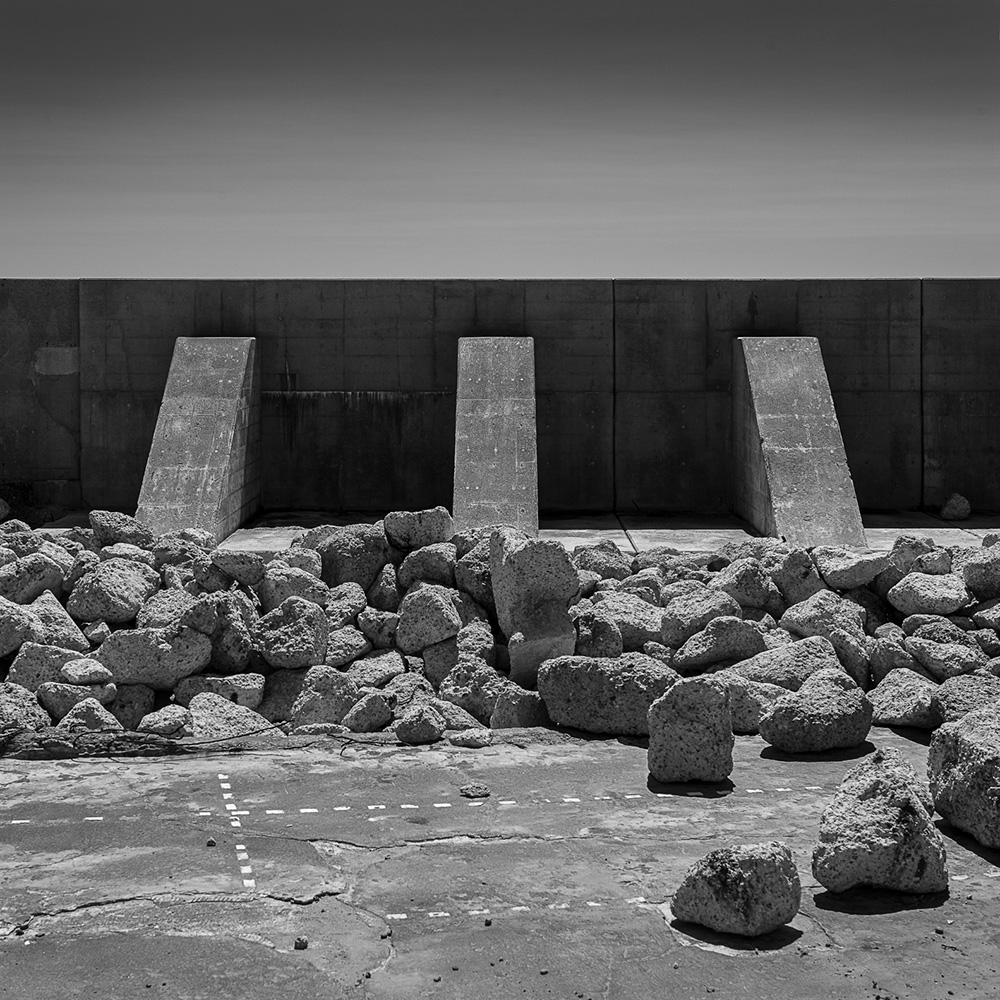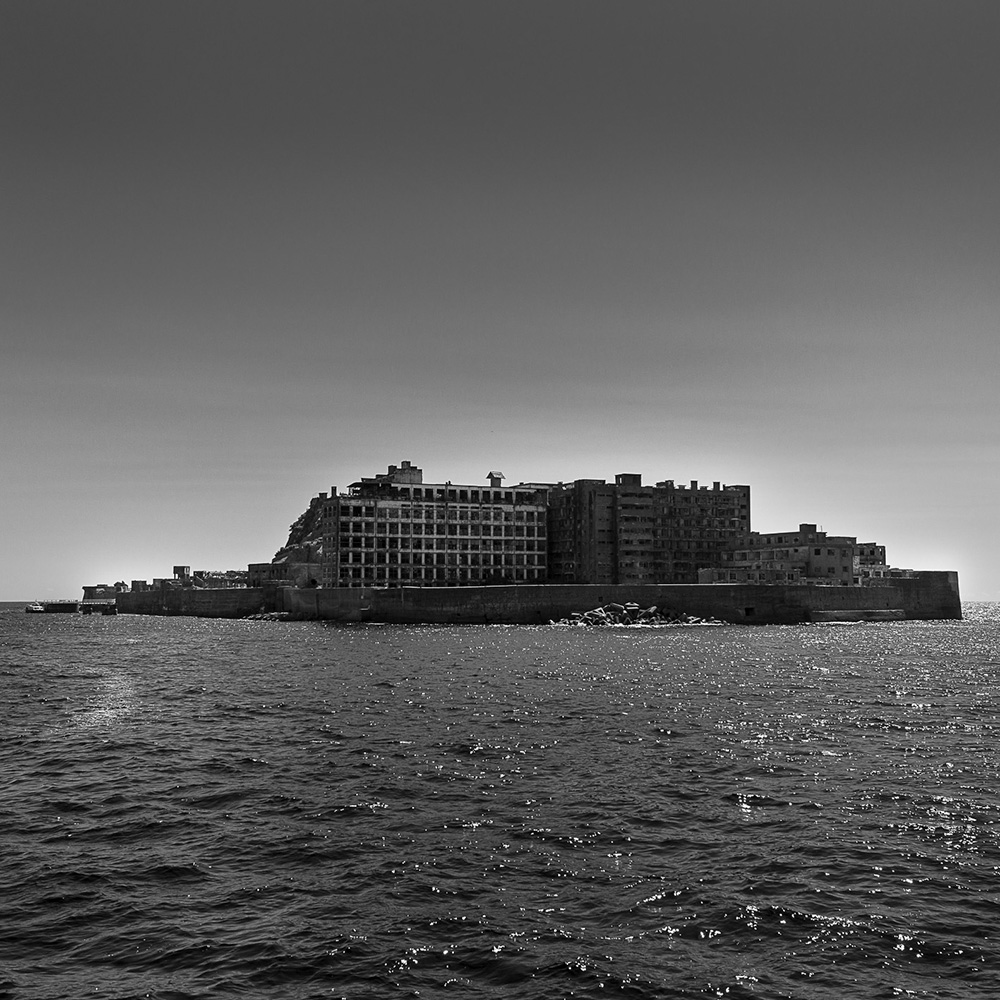Gunkanjima, Scenes after the History
My work is intended to showcase the multifaceted meanings behind “scenes after the formation of historical facts” through the documentation of Gunkanjima. It is almost impossible to know for sure if the proposition “Every documentary is based on historical facts” is true or false even after an event has become part of the historical past. Thus, these photographs were produced while taking note of the multilayered meanings of photographs and their metaphors. Taken in a very short amount of time, these pictures are but a hiccup in a long history. What meaning does the suffering caused by the compulsory manpower draft and the diverse connotations preserved within a site of forced labor have at this moment after so many long years? Distortion in an artist’s perspective and a viewer’s acceptance of such a viewpoint is inevitable. I would like to chronicle inconvenient facts that derive from present political power and capital in photographs through records of short moments in 2013.
역사 이후의 풍경 군함도
군함도의 기록을 통해서 ‘역사적 사실이 만들어진 이후’의 풍경이 가지는 다의적인 의미를 보여주고자 하였다. ‘다큐멘터리는 역사적 사실을 기반으로 한다’는 명제가 반드시 참인가 하는 것은 역사적 사건이 오랜 과거가 된 후에는 사실 불가능하다. 그래서 역사 이후의 사진이 가지는 의미의 중층성과 그것이 만들어낸 새로운 은유에 주목하면서 이 사진들을 제작하였다. 아주 짧은 순간에 제작된 이 사진들은 비극적인 긴 역사에 비하면 찰나에 불과하다. 강제징용의 고통이나 그 장소가 가지는 다양한 함의는 세월이 한참 지난 이 순간에 무엇으로 남아 있을까. 한 개인인 작가의 관점과 그것을 수용하는 관람자의 경험을 통해 왜곡이 만들어 질 수밖에 없다. 2013년에 제작된 짧은 순간의 기록을 통해서 현재의 정치권력과 자본이 만들어낸 불편한 사실을 사진으로 남기고자 한다.
군함도은 완전히 다른 곳이 되어 있었다. 강제징용으로 수많은 사람들이 노역을 당했던 이 섬을 일본은 메이지 근대화의 상징으로 2015년 유네스코 문화 유적에 등재하는 데 성공했다. 일본은 역사적 사실을 확실하게 인정하지 않고 적당이 절충하여 애매모호한 태도를 취하고 있다. 그러는 사이에 그들의 목표가 쟁취되었다. 군함도에는 그들의 정치적인 아젠다가 들어 있다. 일본 군국주의 혈맥의 시조격인 현 일본 총리 아베의 할아버지가 조선인 징용을 주도하여 수많은 조선인들이 일본에 징용 당했다. 아베는 그 장소를 근대화 명소로 만든 것이다. 즉 자신들의 정치적인 목적 때문에 역사적 사실, 혹은 진실들은 더 작은 얘기가 되어 버렸다.
군함도는 일본이 원하는 풍경과 우리가 바라보는 풍경 사이에서 거시적으로 완전히 다른 모습이 되었다. 로제스톤은 “우리가 스크린에서 보는 것은 과거의 창이 아니라 모방한 과거이며, 문자적 현실(literal reality)이 아니라 은유적 현실(metaphoric reality)”이라고 했다. 이는 탈역사가 아니라 과거 역사에 대한 은유이다. 사건 이후의 풍경은 역사의 재현이기보다는 역사 이후의 시간에 의하여 국가나 개인의 사유의 해석에 따라 은유적인 새로운 현실이 되는 것이다. 여기에 바로 ‘역사 이후의 풍경’의 주된 논점이 있다.
차가운 풍경은 중립적인 풍경이다. 즉 나의 마음을 숨긴 풍경이다. 의미망의 확대를 위해서 의미를 주장하기보다는 속마음을 감추는 것이다. 역사에 대한 집단적인 체험을 통해서 다르게 반응하는 한국인과 일본인처럼 개인적인 경험에 의해서 대상에 대하여 현상학적으로 다르게 반응하게 하는 것이다. 건물만 앙상히 남은 광경, 그리고 그것은 부분적으로 파괴되어 있었다. 세월의 무게도 있겠지만 태풍 등의 영향으로 파괴되어 있는 공간이었다. 차가운 풍경은 왜곡을 최대한 절제하여 대상이 스스로 말하도록 한다. 그래서 건물의 수평 수직을 지키면서 건물과 잔해를 촬영했다. 그리고 색을 제거해 흑백사진으로 만들어 최대한 의견을 절제하였다. 광경 그 자체에 집중하여 대상 스스로의 의미를 자아내고자 했다. 사진의 내용을 작가가 주도하기보다는 절제를 통해서 집단의 큰 체험과 개인의 작은 체험이 조우하는 사유의 공간을 확보하여 다의성이 창출되어야 한다는 것이 이 사진에 대한 나의 생각이다.
2017년 6월 10일 사진가 이용환
Gunkanjima, Scenes after the History
My work is intended to showcase the multifaceted meanings behind “scenes after the formation of historical facts” through the documentation of Gunkanjima. It is almost impossible to know for sure if the proposition “Every documentary is based on historical facts” is true or false even after an event has become part of the historical past. Thus, these photographs were produced while taking note of the multilayered meanings of photographs and their metaphors. Taken in a very short amount of time, these pictures are but a hiccup in a long history. What meaning does the suffering caused by the compulsory manpower draft and the diverse connotations preserved within a site of forced labor have at this moment after so many long years? Distortion in an artist’s perspective and a viewer’s acceptance of such a viewpoint is inevitable. I would like to chronicle inconvenient facts that derive from present political power and capital in photographs through records of short moments in 2013.
Gunkanjima, where countless people once suffered under forced labor, has changed completely. The island was successfully registered as a UNESCO World Heritage site in 2015 by the Japanese government as a symbol of Japan’s Meiji Restoration. Japan has taken an ambiguous position by not admitting historical facts. In the meantime, they achieved their goal by using Gunkanjima as a means to raise their political agenda. The grandfather of Shinzo Abe, the current Prime Minister of Japan, drafted a large number of Korean people to Gunkanjima while his son made the site into an attraction of modernization. Historical facts and truths have been dwindled down for their political purposes.
Gunkanjima shows a difference between what Japan wants and what we view. Robert A. Rosenstone argues that “What we see on the screen is not a window onto the past but a construction of a simulated past, not a literal reality but a metaphoric one.” This is not post-history but a metaphor for a past history. A scene following an event is a new metaphoric reality that depends on a nation or an individual’s interpretation, not a representation of history. Found here is the key point of Scenes after the History.
Coldhearted scenes are neutral ones. They conceal my heart. Instead of offering any meaning, they cover up my heart and extend a semantic network. We react differently to objects according to our individual experiences just as Korean and Japanese people react differently on account of their different collective experience with history. Only the shells of the buildings remain as they were partly destroyed by typhoons and the weight of time. I let objects speak for themselves in such cold scenes in order to avoid the use of distortion. The ruins of buildings were photographed to keep their horizontal and vertical balance. I let objects generate their own meaning and just highlight the scene itself. I think these photographs bring about multifaceted meanings by offering the space of thoughts where collective experiences meet individual ones rather than leading their contents by the artist.
YongHwan Lee
군함도
나가사키에서 19km 떨어진 하시마라는 작은 섬에는 석탄이 많았다. 일본은 산업화로 엄청나게 필요한 에너지원의 일부를 이곳의 해저 탄광에서 채우고자 했다. 일본 최초의 아파트가 건립된 이 섬은 1959년 세계에서 가장 인구 밀도가 높은 지역이 되었다. 1974년 1월 15일, 이 섬의 상주 인력의 완전 철수가 결정되었다.
이 섬은 현재 무인도로 훼손을 막기 위하여 30분 정도만 상륙을 허가하고 있다. 일제시대 말기에 우리 조선인 약 800여명이 이곳으로 징용 와서 고된 노역을 하였고 이중 122명이 사망했다. 한국인 징용자에게는 아직도 임금을 지불하지 않고 있다. 일본 정부에서는 일본에 강제 징용된 한국인 노동자가 70만명이라고 한다. 일본 사법부는 보상해야 한다고 판결했지만 일본 정부는 집행을 미루고 있다. 피해자들은 손해배상보다는 진정 어린 사과가 선행되어야 한다고 주장한다.
Gunkanjima
Hashima Island (also commonly called Gunkanjima and Battleship Island) lies about 19 kilometers away from the city of Nagasaki and once possessed a large amount of coal reserves. The Japanese government tried to meet energy demands that were caused by the country's rapid industrialization with coal obtained from its undersea coal mines. In 1959 this island was the most populated region in the world and was where the first Japanese apartments were built. On January 15, 1974 the Japanese government decided to withdraw all of the settled population from this island.
Currently only a 30-minute stay on this uninhabited island is allowed to prevent environmental damage. About 800 Koreans suffered from forced labor here in the late period of Japanese colonial rule with 122 of them dying due to the harsh working conditions. The Japanese government still does not pay back wages to the 700,000 draftees throughout Japan. The Japanese court ruled to compensate the Korean workers but the Japanese government has postponed its execution.
이용환/李庸煥/YongHwan Lee
현재
중앙대학교 예술대학 공영영상창작학부장, 사진전공 교수
학력
중앙대학교 사진학과, 미술학사, 1985
중앙대학교 대학원 사진학과, 미술석사, 1989
중앙대학교 신문방송대학원, 영상매체전공, 문학석사, 1992
Ohio University, Visual Communication, Muti-Media, MA, 2002
주요경력
유럽 최고 권위의 잡지인 ‘European Photography’ 100호 기념, 세계 100장의 사진작품의 작가로 선정, 2016
감독 및 큐레이터, Net Photo Festival, 대구사진비엔날레 2016
리뷰어, European Month of Photography, Berlin, 2014
한국사진학회 회장, 2010~2014,
17화 체코 프레스포토 심사위원 2011
대구사진비엔날레 감독 2010
개인전
이용환 개인전, 핑야오국제사진페스티벌, 중국, 2015
정치적인풍경 2014, 이연주 갤러리, 부산, 2014
정치적인풍경, 통제된 자연, onomato künstlerverein, 뒤쉘도르프, 2013
Rectangle. Red .Control, C space, 북경, 2012.12
정치적인풍경, 자하미술관, 서울. 2011.
그룹전
제2회 충칭 장강사진비디오비엔날레, 중국, 2017
제3회 난징국제아트페스티벌, Historicord, Baija Lake Museum, 중국 2016
Dream&Reality, 제 6회 다리 국제 사진전, 중국, 2015
‘순간 속 정지’, 울산국제사진페스티벌, 2013
제1회 한국일본사진비엔날레, 실크갤러리와 인데코 갤러리, 2000
'이것이 사진이다’, 삼성 사진 갤러리, 서울, 1996
YongHwan Lee
Dean, School of Performing Arts and Media
Professor, Photography,C hung Ang University
B.A-Photography, Chung-Ang Univ, Seoul, 1985
M.F.A-Photography, Chung-Ang Univ, Seoul, 1989
M.A- Video, Chung-Ang Univ, Seoul, 1992
Ohio University. Visual Communication, M.A, 2002
Nominated photographer of World's great 100 photographs, celebrating 100th issue of European Photography, Europe's most prestigious magazine, 2016
Director, Net Photo Festival, Daegu Photo Biennale, 2016
Reviewer, 2014 European Month of Photography, Berlin
Member of the international jury, 17th CZECH PRESS PHOTO 2011
Director, Daegu Photo Biennale, 2010
Solo Exhibition
YongHwanLee Solo Show, Pingyao International Photography Festival, China, 2015
Political Landscape 2014, Leeyeonjoo Gallery, Busan Korea, 4 Nov 2014
Political Landscape, Controlled Nature, onomato künstlerverein, Düsseldorf, Dec 2013
Rectangle. Red .Control, C Space, Beijing, 2012
Political Landscape, Jaha Museum, Seoul. 2011
Group Exhibition
The Second Edition of Chongqing International Photography & Video Biennale, China, 2017
3th Nanjing International Art Festival, Historicord, Baija Lake Museum,China 2016
Dream&Reality, The Sixth Dali International Photograph Exhibition, China, 2015
‘Stillness in Movement’, Ulsan International Photo Festival, 2013
The 1st Korean and Japan Photo Biennale, Silk Gallery and Indeco Gallery, 2000
'Photography as it is’, Samsung Photo gallery, Seoul, 1996


